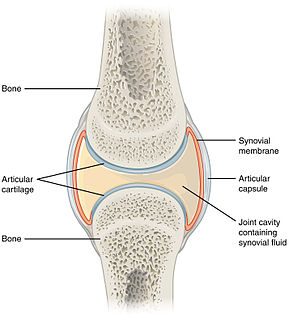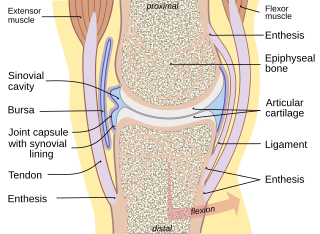
A joint or articulation is the connection made between bones in the body which link the skeletal system into a functional whole. They are constructed to allow for different degrees and types of movement. Some joints, such as the knee, elbow, and shoulder, are self-lubricating, almost frictionless, and are able to withstand compression and maintain heavy loads while still executing smooth and precise movements. Other joints such as sutures between the bones of the skull permit very little movement in order to protect the brain and the sense organs. The connection between a tooth and the jawbone is also called a joint, and is described as a fibrous joint known as a gomphosis. Joints are classified both structurally and functionally.
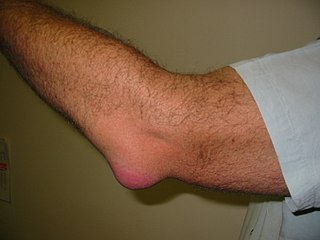
Bursitis is the inflammation of one or more bursae of synovial fluid in the body. They are lined with a synovial membrane that secretes a lubricating synovial fluid. There are more than 150 bursae in the human body. The bursae rest at the points where internal functionaries, such as muscles and tendons, slide across bone. Healthy bursae create a smooth, almost frictionless functional gliding surface making normal movement painless. When bursitis occurs, however, movement relying on the inflamed bursa becomes difficult and painful. Moreover, movement of tendons and muscles over the inflamed bursa aggravates its inflammation, perpetuating the problem. Muscle can also be stiffened.

Hyaline cartilage is the glass-like (hyaline) but translucent cartilage found on many joint surfaces. It is also most commonly found in the ribs, nose, larynx, and trachea. Hyaline cartilage is pearl-grey in color, with a firm consistency and has a considerable amount of collagen. It contains no nerves or blood vessels, and its structure is relatively simple.

A synovial sarcoma is a rare form of cancer which occurs primarily in the extremities of the arms or legs, often in close proximity to joint capsules and tendon sheaths. It is a type of soft tissue sarcoma.

A synovial bursa is a small fluid-filled sac lined by synovial membrane with an inner capillary layer of viscous synovial fluid. It provides a cushion between bones and tendons and/or muscles around a joint. This helps to reduce friction between the bones and allows free movement. Bursae are found around most major joints of the body.

Synovial osteochondromatosis (SOC) is a rare disease that creates a benign change or proliferation in the synovium or joint-lining tissue, which changes to form bone-forming cartilage. In most occurrences, there is only one joint affected, either the knee, the hip, or the elbow. Rarely involves the TMJ.
Synovitis is the medical term for inflammation of the synovial membrane. This membrane lines joints that possess cavities, known as synovial joints. The condition is usually painful, particularly when the joint is moved. The joint usually swells due to synovial fluid collection.

In anatomy, a joint capsule or articular capsule is an envelope surrounding a synovial joint. Each joint capsule has two parts: an outer fibrous layer or membrane, and an inner synovial layer or membrane.

In animal anatomy, a pivot joint is a type of synovial joint. In pivot joints, the axis of a convex articular surface is parallel with the longitudinal axis of the bone.
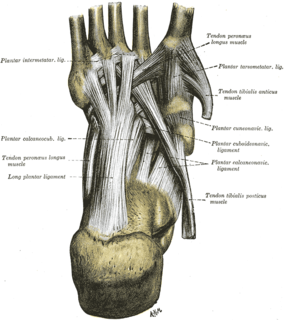
The tarsometatarsal joints are arthrodial joints in the foot. The tarsometatarsal joints involve the first, second and third cuneiform bones, the cuboid bone and the metatarsal bones.
The eponym Lisfranc joint is named after 18th-19th century surgeon and gynecologist, Jacques Lisfranc de St. Martin.

Intermetatarsal joints - The base of the first metatarsal is not connected with that of the second by any ligaments; in this respect the great toe resembles the thumb.

The intercarpal joints can be subdivided into three sets of joints : Those of the proximal row of carpal bones, those of the distal row of carpal bones, and those of the two rows with each other.
Plica syndrome is a condition that occurs when a plica becomes irritated, enlarged, or inflamed.
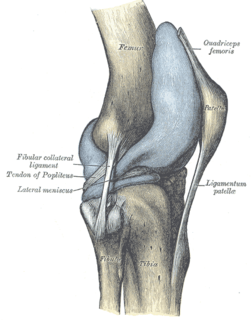
The articular capsule of the knee joint is wide and lax; thin in front and at the side; and contains the patella, ligaments, menisci, and bursae. The capsule consists of a synovial and a fibrous membrane separated by fatty deposits anteriorly and posteriorly.
Synovectomy is a procedure where the synovial tissue surrounding a joint is removed. This procedure is typically recommended to provide relief from a condition in which the synovial membrane or the joint lining becomes inflamed and irritated and is not controlled by medication alone. If arthritis is not controlled, it can lead to irreversible joint damage. The synovial membrane or "synovium" encloses each joint and also secretes a lubricating fluid that allows different joint motions such as rolling, folding and stretching. When the synovium becomes inflamed or irritated, it increases fluid production, resulting in warmth, tenderness, and swelling in and around the joint.
Arthrocentesis is the clinical procedure of using a syringe to collect synovial fluid from a joint capsule. It is also known as joint aspiration. Arthrocentesis is used in the diagnosis of gout, arthritis, and synovial infections such as septic arthritis.
Synovial sarcoma, X breakpoint (SSX) refers to a group of genes rearranged in synovial sarcoma.

